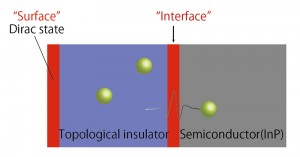Detection of Dirac state at a solid-state interface Towards low-power electronic devices based on topological insulators

Topological insulators are a new class of semiconductor that are insulators internally but possess a conducting metallic surface layer. This surface layer is what termed a metallic Dirac electron state, also found in other materials such as graphene, in which electrons behave as if they were massless particles. As a result electron conductivity that consumes almost no energy at all is possible, and consequently topological insulators are receiving much attention for their potential application to low-power electronic devices.

© R. Yoshimi, A. Tsukazaki, K. Kikutake, J. G. Chckelsky, K. S. Takahashi, M. Kawasaki, Y. Tokura.
Metallic Dirac states (red region) are formed at the boundaries between a topological insulator and a vacuum or a solid-state material, which correspond to the surface and the interface, respectively. Dirac state was detected by electron tunneling spectroscopy across the solid-state interface. Green balls illustrate the tunneling electrons.
Researchers at the Graduate School of Engineering Department of Applied Physics at the University of Tokyo, headed by Professor Yoshinori Tokura, in collaboration with PhD candidate Ryutaro Yoshimi and members of the RIKEN Center for Emergent Matter Science (CEMS), have demonstrated for the first time that the Dirac state of a topological insulator is stably-formed at the solid-state interface. This was electrically detected by tunneling spectroscopy across the interface between a recently discovered topological insulator ((Bi 1-x Sbx)2Te3, Bi: Bismuth, Sb: Antimony, Te: Tellurium) and a conventional semiconductor (InP, Indium Phosphide). (Tunneling spectroscopy measures ease of flow of tunneling current, a phenomenon observed when a small particle such as an electron passes through a physical obstacle as a wave.) In addition, the Dirac states in the semiconductor junction device are well controlled by the composition of the topological insulator.
This research has demonstrated that the Dirac state is preserved even as the solid-state interface between two materials, an essential prerequisite for the development of solid-state devices. These achievements reveal the possibility of new functional devices based on the Dirac state of topological insulators combined with conventional semiconductor technologies and is a major step toward the realization of low power devices.
This research was supported by the Japan Society for the Promotion of Science through the Funding Program for World-Leading Innovative R&D on Science and Technology (FIRST Program) on “Quantum Science on Strong Correlation” initiated by the Council for Science and Technology Policy and by JSPS Grant-in-Aid for Scientific Research (S) No. 24224009 and No. 24226002。
Paper
R. Yoshimi, A. Tsukazaki, K. Kikutake, J. G. Checkelsky, K. S. Takahashi, M. Kawasaki, Y. Tokura,
“Dirac electron states formed at the heterointerface between a topological insulator and a conventional semiconductor”,
Nature Materials, Online Edition: 2014/2/20, Japan Time:19:00, doi: 10.1038/NMAT3885.
Article link
Links
Graduate School of Engineering
Department of Applied Physics, Graduate School of Engineering
Tokura Laboratory, Department of Applied Physics, Graduate School of Engineering






